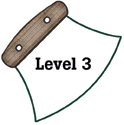
Alaska Science
Key Element A5
A student who meets the content standard should understand the strength and effects of the forces of nature, including gravity and electromagnetic radiation (Forces of Nature).
 |
Alaska Science A student who meets the content standard should understand the strength and effects of the forces of nature, including gravity and electromagnetic radiation (Forces of Nature). |
|
Performance Standard Level 3, Ages 11–14
|
|
|
|
Sample Assessment Ideas
|
Standards Cross-References
|
||
|
National Science Education Standards Gravity is the force that keeps planets in orbit around the sun and governs the rest of the motion in the solar system. Gravity alone holds us to the Earth’s surface and explains the phenomena of the tides. (Page 161) Light interacts with matter by transmission (including refraction), absorption, or scattering (including reflection). To see an object, light from that object—emitted by or scattered from it—must enter the eye. (Page 155) Electrical circuits provide a means of transferring electrical energy when heat, light, sound, and chemical changes are produced. (Page 155) The sun is a major source of energy for changes on the Earth’s surface. The sun loses energy by emitting light. A tiny fraction of that light reaches the Earth, transferring energy from the sun to the Earth. The sun’s energy arrives as light with a range of wavelengths, consisting of visible light, infrared, and ultraviolet radiation. (Page 155) |
Benchmarks Light from the sun is made up of a mixture of many different colors of light, even though to the eye the light looks almost white. Other things that give off or reflect light have a different mix of colors. (Page 90) Every object exerts gravitational force on every other object. The force depends on how much mass the objects have and on how far apart they are. The force is hard to detect unless at least one of the objects has a lot of mass. (Page 95) The sun’s gravitational pull holds the Earth and other planets in their orbits, just as the planets’ gravitational pull keeps their moons in orbit around them. (Page 95) Electric currents and magnets can exert a force on each other. (Page 95) |
|
Table of Contents | Return to Alaska Native Knowledge Network